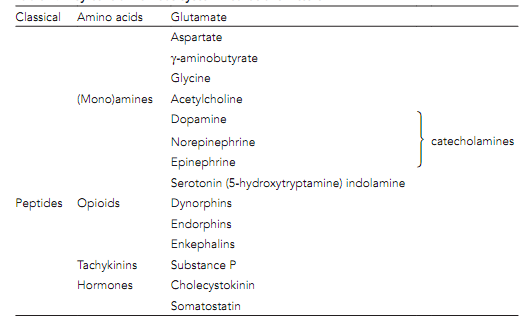Chemical transmission
Most of the synapses are chemical. At a usual CNS synapse the entrance of an action potential at the axon terminal may, or may not, trigger the release of neurotransmitter from a single presynaptic vesicle. The transmitter release needs a rise in intracellular Ca2+ brought about by calcium entry into the axon terminal through voltage-dependent calcium channels. The transmitter diffuses around the synaptic cleft in about 5 µs. At the postsynaptic membrane it binds to particular receptors, causing a change in the receptor conformation. What happens next depends on the receptor, while the overall outcome is to change the postsynaptic membrane permeability to particular ions.
The Neurotransmitter receptors come into two superfamilies. The ligand-gated ion channels (LGICs), also termed as ionotropic receptors, have ion-selective channels as section of the receptor. The binding of transmitter to the receptor opens the channel, directly growing its permeability. The second superfamily is the G-protein-coupled receptors (GPCRs). These are the major group of metabotropic receptors, so called as they can modulate metabolic activities. The binding of transmitter to these receptors activates their related G proteins which are capable of diverse and remote effects on membrane excitability, permeability, and metabolism. The G proteins can influence permeability either by binding ion channels directly or by altering the activity of second messenger system enzymes that phosphorylate ion channels, thereby modifying their permeability.
The modifications in membrane properties brought about by a transmitter produce postsynaptic potentials, small shifts in the membrane potential that can have necessarily one of two effects. It may increase the probability which the postsynaptic neuron fires action potentials, in which situation the response is excitatory. If the effect is to reduce the probability that the postsynaptic cell might fire, the response is inhibitory. It is generally the situation that a transmitter is excitatory at one of its receptors,while inhibitory at the other, therefore it is a synapse which is excitatory or inhibitory instead of the transmitter per se.
The numerous molecules have been specified as neurotransmitters. The classical transmitters are amino acids small molecules, or amines. Quantitatively by far the most significant are glutamate, that is almost invariably excitatory, and g-aminobutyrate (GABA) that is generally inhibitory. This group also involves acetylcholine, the catecholamines like dopamine and noradrenaline and the indoleamine, serotonin. The second, superior, group is an eclectic mix of peptides that includes the opioids (like endorphins) and the tachykinins (example, substance P). See the table as shown for a far from exhaustive list.

Table:Key central nervous system neurotransmitters
The Neurotransmission falls into two wide categories based on its time course. The Fast transmission takes place whenever a neurotransmitter acts through LGICs, while slow transmission takes place whenever transmitters act at GPCRs. The Glutamate, GABA, and acetylcholine (ACh) are altogether responsible for most of the fast transmission. Though, each of these molecules also mediates slow transmission by activating their corresponding GPCR. Certainly, a transmitter can mediate both fast and slow transmission at similar synapse by activating multiple receptor populations. For illustration, ACh released from preganglionic cells acts on both nicotinic and muscarinic receptors on postganglionic cells in autonomic ganglia, mediating fast and slow effects of ACh correspondingly. Peptide transmission and Catecholamine are invariably slow.
It is extremely general for a given synapse to release more than one transmitter. This cotransmission generally includes the release of a classical transmitter, attached with the co-release of one or more peptides at higher firing frequencies. The transmitters are quickly cleared from the synaptic cleft after release by passive diffusion away from the cleft, reuptake into nearby glia or neurons, or the enzyme degradation.